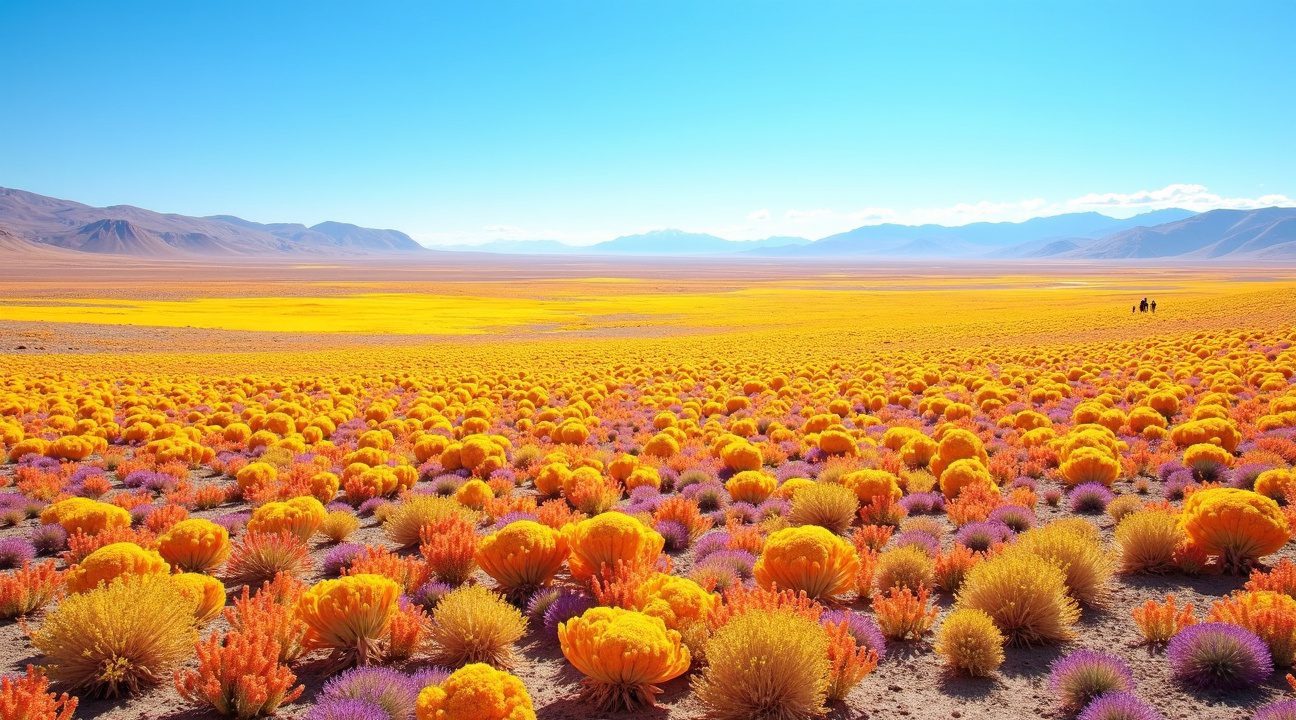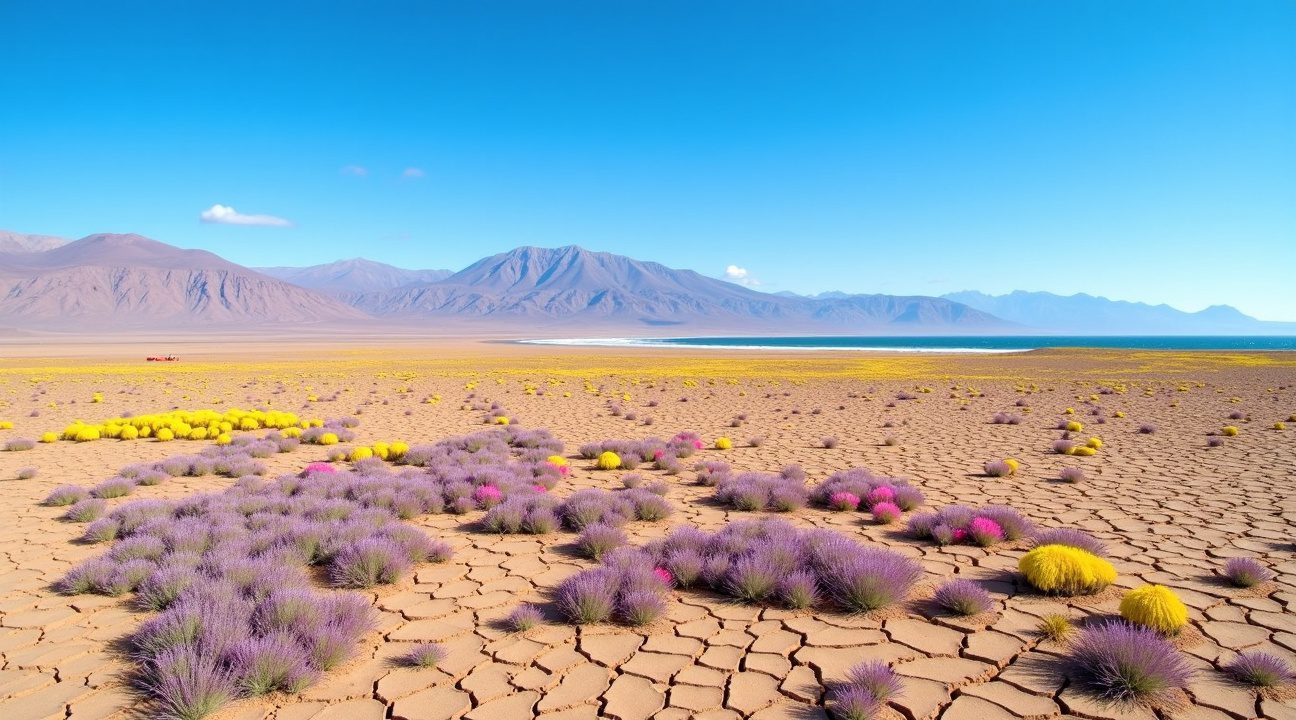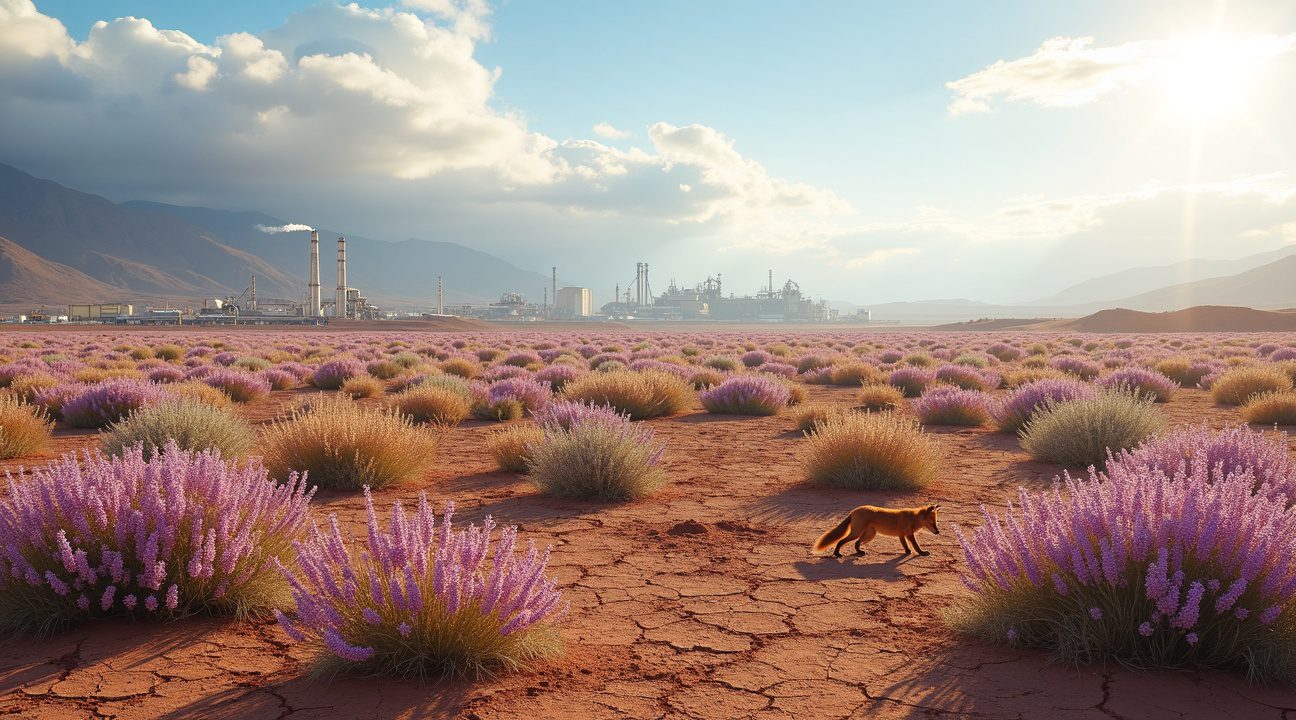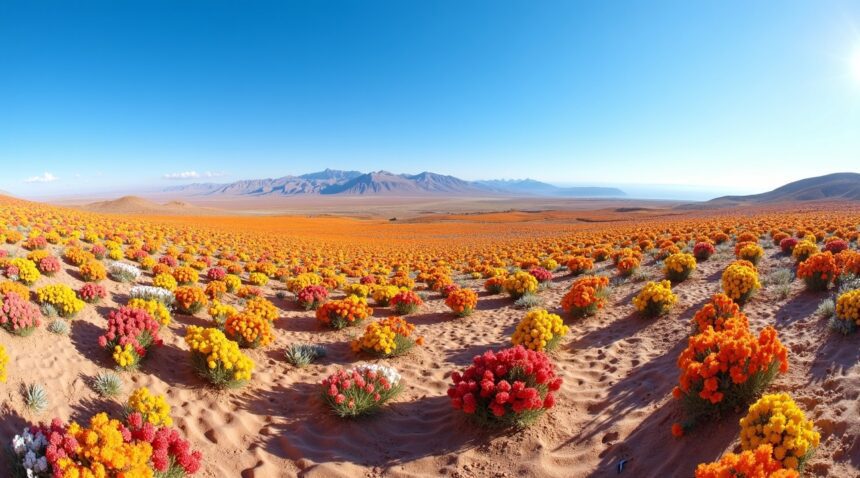Flowers have erupted across Chile’s Atacama Desert in September 2025, marking the first time in a decade that this spectacular blooming phenomenon has transformed the globe’s driest non-polar desert into a vibrant carpet of wildflowers.
This extraordinary event, known locally as Desierto Florido, was triggered by substantial winter rains in early August that awakened over 200 endemic plant species from years of dormancy across hundreds of miles of previously barren terrain.
Key Takeaways
- The Atacama Desert bloom spans hundreds of miles from Totoral to Caleta Chañaral de Aceituno, with Llanos de Challe National Park serving as the centerpiece of this 113,000-acre floral display expected to peak throughout October.
- Over 200 endemic wildflower species participate in this rare phenomenon, including the dominant yellow and red añañucas, purple huilli flowers, and the unique orange-red lion’s claw found nowhere else on Earth.
- These blooming events occur only when rare rainfall breaks the region’s typical multi-year drought cycles, with El Niño weather patterns playing a crucial role in providing the precise moisture conditions needed to trigger seed germination.
- The flowers must complete their entire life cycle within just a few months before the desert returns to its arid state, creating an urgent biological race that transforms the landscape almost overnight.
- Environmental pressures including water scarcity from mining operations, industrial development, and climate change threaten the delicate conditions required for future blooming events in this extremely fragile ecosystem.
To learn more about this natural marvel, you can explore additional details on the official Chile tourism website.
A Spectacular Carpet of Wildflowers Transforms Earth’s Most Barren Landscape
September 2025 marked an extraordinary transformation as the Atacama Desert erupted into vibrant blooms, creating one of nature’s most dramatic spectacles. I witnessed this incredible phenomenon firsthand as substantial winter rains in early August triggered a dormant ecosystem back to life for the first time in a decade.
The Magnificent Scale of Desierto Florido
The bloom began during the third week of September and stretches across hundreds of miles of previously barren terrain. I can see this colorful carpet extending from Totoral in the north all the way to Caleta Chañaral de Aceituno in the south. Llanos de Challe National Park serves as the crown jewel of this display, with its 113,000 acres transformed into a breathtaking canvas of wildflowers expected to peak throughout October.
This phenomenon, known locally as Desierto Florido, happens only when rare rainfall breaks the region’s typical multi-year drought cycles. The desert’s extreme conditions create perfect preservation for dormant seeds that can wait decades for the right moisture conditions. These seeds spring to life almost overnight, creating displays so vivid they can be seen from space.
Over 200 endemic flower species participate in this remarkable showcase, each adapted specifically to survive in Earth’s driest environment. The yellow and red añañucas dominate much of the landscape, their bright petals creating waves of color across the sandy terrain. Huilli flowers add delicate purple hues to the mix, while the striking lion’s claw (Leontochir ovallei) stands out with its unique orange and red blooms.
I find the timing particularly fascinating because these flowers must complete their entire life cycle within just a few months before the desert returns to its typical arid state. Each species has evolved precise timing mechanisms to maximize reproduction during these brief windows of opportunity. The result creates layers of color that shift throughout the blooming period as different species reach their peak flowering times.
This natural event attracts visitors from around the world, though I recommend planning carefully as the remote location requires proper preparation. The blooms offer photographers and nature enthusiasts a once-in-a-decade opportunity to witness life triumphing over one of Earth’s most challenging environments. Scientists also use these events to study desert ecology and climate patterns, as the blooms serve as natural indicators of significant weather changes in this otherwise predictable ecosystem.

Why This Desert Holds the Record for Extreme Aridity
The Atacama Desert in northern Chile claims the title of Earth’s driest nonpolar desert, a distinction that makes the recent flower blooming event truly extraordinary. I find it remarkable that some sections of this vast landscape receive less than 1 millimeter of rainfall each year, while certain areas have experienced decades without any measurable precipitation. Only Antarctica’s inner valleys can rival such extreme dryness.
This hyper-arid environment stretches over 1,000 kilometers along the western Andes, creating a stark barrier between the mountains and the Pacific Ocean. The desert’s record-breaking aridity results from a perfect storm of geographical factors that work together to create one of Earth’s most inhospitable environments.
The Science Behind Extreme Dryness
Two primary forces combine to create the Atacama’s legendary dryness:
- The rain shadow effect of the Andes Mountains blocks moisture-laden air masses from reaching the desert.
- The cold Humboldt Current flowing along the coast prevents humid air from accumulating over the region.
These conditions create an atmospheric barrier that effectively locks out precipitation.
The cold ocean current plays a particularly crucial role in maintaining the desert’s arid conditions. As warm air rises from the land and meets the cold air above the current, it creates a temperature inversion that traps moisture at low altitudes. This phenomenon prevents cloud formation and rainfall, maintaining the desert’s status as an extreme environment where life struggles to exist.
Understanding these extreme conditions makes the recent flowering event even more significant. The combination of geographical barriers and oceanic influences has created a landscape so dry that some weather stations have recorded zero precipitation for consecutive years. When rain finally does arrive in sufficient quantities, it transforms this barren landscape into something completely unexpected.
The Atacama’s reputation for extreme aridity has made it a valuable research location for scientists studying Mars-like conditions and extremophile organisms. Some areas are so devoid of moisture that they mirror conditions found on other planets, making them ideal testing grounds for space exploration technology.
This desert’s record-breaking dryness stems from its unique position between powerful natural forces. The recent bloom represents a rare disruption of these normally stable atmospheric patterns, creating conditions that haven’t occurred in a decade.

The Rare Conditions That Trigger This Natural Wonder
I find it fascinating how nature can persist in one of Earth’s most hostile environments. The Atacama Desert presents extreme conditions that keep most plant life in a state of suspended animation for years at a time. Seeds and bulbs lie buried beneath the parched surface, waiting patiently for that perfect moment when conditions align to support their brief emergence into the world above.
The Critical Role of Rainfall Thresholds
The trigger for these spectacular blooms comes down to a surprisingly small amount of water. Just a few millimeters of rainfall can awaken dormant seeds that have been waiting underground for years. This threshold might seem insignificant compared to what plants in other regions require, but in the Atacama, even this modest precipitation represents a rare gift from the skies.
El Niño’s Powerful Influence on Desert Blooms
Weather patterns play the starring role in creating these magical displays. The El Niño-Southern Oscillation drives most of these flowering events by warming sea temperatures along the Pacific coast. This warming effect enhances rainfall patterns across the region, providing the precise conditions needed to break the seeds’ long dormancy. Without this climatic phenomenon, the desert would likely remain barren for even longer periods.
Recent blooming events tell an interesting story about changing patterns. While these displays historically occurred every 5 to 7 years, I’ve observed notable blooms in 2015, 2017, and 2022. This apparent increase in frequency suggests that shifting climate patterns might be creating more opportunities for these rare spectacles to unfold.
The Atacama stands apart from other desert environments in its unforgiving nature. Where other arid regions might experience modest but regular flowering events, the Atacama’s rigid environmental thresholds create a different dynamic entirely. The desert demands specific conditions that align only rarely, making each bloom a truly exceptional occurrence rather than a predictable seasonal event.
These stringent requirements mean that when conditions finally align, the impact becomes exponentially more dramatic. Seeds that have waited a decade or more suddenly burst into action, creating carpets of color that transform the landscape almost overnight. The contrast between the typical barren moonscape and these vibrant displays of life creates one of nature’s most striking transformations.
Understanding these mechanisms helps explain why each bloom feels so precious and temporary. The flowers know their window of opportunity is brief, so they rush through their entire life cycle in a matter of weeks. This urgency creates an intensity that makes the record-breaking displays even more remarkable, as millions of plants simultaneously respond to the same rare environmental cues that awakened them from their long slumber.
The Incredible Biodiversity That Emerges From Nowhere
The Atacama Desert’s sudden transformation reveals one of nature’s most extraordinary spectacles, where barren moonscape suddenly erupts into a vibrant display of life. Over 200 wildflower species emerge during these rare blooming events, creating an unexpected oasis in the world’s driest place. I find it fascinating how these dormant seeds wait patiently for years, sometimes decades, beneath the surface until conditions align perfectly for germination.
The Stars of the Desert Show
Among the most prominent performers in this desert theater stands the añañuca, represented by various Rhodophiala species that paint the landscape in brilliant yellows and reds. These bulbous plants create stunning carpets across the desert floor, their vibrant blooms contrasting dramatically against the stark terrain. The white-flowered huilli adds delicate touches throughout the landscape, while the visually striking lion’s claw (Leontochir ovallei) commands attention as a thistle relative found nowhere else on Earth.
Each species brings its own timing and characteristics to this brief but intense flowering period. I’ve observed how these plants have adapted their reproductive cycles to maximize the limited window of opportunity, producing seeds rapidly before the harsh conditions return. The lion’s claw particularly stands out with its distinctive spiny appearance and robust flowers that seem almost defiant in their desert setting.
A Temporary Ecological Paradise
This sudden explosion of flora transforms the Atacama into a temporary hub of biodiversity that supports life far beyond the flowers themselves. The blooming desert provides critical yet ephemeral food and habitat resources for insects, birds, and small mammals that have similarly adapted to capitalize on these rare events. Hummingbirds arrive to feast on nectar, while various bee species emerge to collect pollen, creating a buzzing symphony across the normally silent landscape.
Within just a few weeks, the Atacama’s otherwise barren terrain becomes a bustling ecological network where every organism races against time:
- Butterflies and moths appear from dormancy.
- Larvae emerge to feed on new vegetation.
- Small mammals take advantage of food surplus.
- Predatory birds follow increased prey activity.
The interconnected web of life that emerges demonstrates how desert ecosystems can support remarkable biodiversity when conditions permit. I’m continually amazed by how quickly these relationships establish themselves, with pollinators finding flowers, herbivores locating fresh vegetation, and predators tracking their prey across this temporary wonderland. The timing becomes crucial as each species must complete essential life cycle activities before the desert returns to its harsh, dormant state.
This ecological burst creates a ripple effect that extends beyond the immediate blooming period. Seeds produced during this brief window will wait for the next favorable conditions, potentially years or decades away, while the animals that benefited from the abundance carry the effects forward in their own survival and reproduction. Even after the flowers fade and the desert reclaims its austere appearance, the impact of these extraordinary blooming events continues to influence the intricate web of desert life.
The speed at which this transformation occurs highlights the remarkable adaptations these species have developed over millennia. From specialized root systems that can quickly absorb rare moisture to reproductive strategies that maximize genetic diversity in minimal time, every aspect of this desert bloom represents evolutionary perfection. The result is a brief but spectacular demonstration of life’s persistence in even the most challenging environments on Earth.
Tourism Boom and Conservation Challenges
The spectacular flower bloom in Chile’s Atacama Desert has triggered an unprecedented surge in tourism, drawing thousands of visitors eager to witness this extraordinary natural phenomenon. I’ve observed how travelers from around the globe flock to this remote region, many combining their desert flower pilgrimage with astrophotography expeditions under the Atacama’s famously clear, unpolluted skies.
This sudden influx presents a delicate balancing act for local authorities and conservationists. The desert’s ecosystem remains incredibly fragile, having evolved over millennia to survive in Earth’s most arid conditions. Officials have responded by implementing strict low-impact tourism guidelines designed to protect these vulnerable landscapes while still allowing visitors to experience their beauty.
Essential Conservation Practices for Desert Visitors
Responsible tourism in the Atacama requires adherence to several critical practices:
- Staying strictly on designated trails and marked pathways to prevent soil compaction and root damage
- Avoiding any contact with blooming plants or disturbing the delicate desert floor ecosystem
- Refraining from collecting seeds, flowers, or any natural specimens as souvenirs
- Carrying out all waste and leaving absolutely no trace of human presence
- Maintaining respectful distances from wildlife and nesting areas
- Using only designated camping and parking areas to minimize environmental impact
Climate change poses an additional threat to these rare blooming events, potentially altering rainfall patterns that trigger flower emergence. Human disturbance compounds these challenges, as even seemingly minor actions like stepping off trails can damage plants that may take years or decades to recover in such harsh conditions.
The desert’s pristine night skies, which attract astronomy enthusiasts year-round, face similar preservation challenges. Light pollution from increased tourism infrastructure could compromise the very qualities that make the Atacama special for both space observation and scientific research.
Local communities have embraced sustainable tourism models that provide economic benefits while protecting their natural heritage. Tour operators now emphasize education about desert ecology and the importance of conservation, helping visitors understand how their actions directly impact these remarkable ecosystems.
Conservation experts stress that maintaining the health and frequency of future blooms depends entirely on minimizing human impact during these vulnerable periods. Each flowering event represents a complex interplay of environmental factors that took years to align perfectly, making protection efforts absolutely essential for preserving this natural wonder for future generations.
Environmental Pressures Threatening Future Blooms
I observe significant challenges threatening the rare phenomenon that transforms Chile’s Atacama Desert into a vibrant carpet of flowers. Multiple environmental pressures work against the delicate conditions needed for the Desierto Florido to emerge again.
Water Scarcity and Competing Demands
Population growth creates mounting pressure on the region’s already limited water resources. Industrial operations consume massive quantities of water, while mining companies extract groundwater at unprecedented rates. I notice how these activities compound the natural water scarcity that defines this extreme environment.
The extraction of water from fossil aquifers presents a particularly concerning trend. These ancient underground reservoirs accumulated water over thousands of years and recharge at extremely slow rates. Once depleted, they may never recover within human timescales. Mining operations and expanding communities rely heavily on these irreplaceable water sources, creating long-term sustainability issues that could permanently alter the desert’s ecosystem.
Industrial Development vs. Natural Phenomena
Desalination plants operate throughout the region, but their output primarily serves industrial purposes rather than supporting local communities or environmental needs. I find this allocation troubling because it highlights how economic priorities often overshadow ecological preservation. While these facilities could theoretically provide water for environmental restoration, current infrastructure focuses on supporting massive industrial projects instead.
The combined impact of these factors creates a feedback loop that undermines the precise conditions required for desert blooms. El Niño events must deliver exactly the right amount of rainfall at specific times for seeds to germinate and flowers to emerge. However, when groundwater levels drop and soil moisture decreases due to human activities, even adequate rainfall may not trigger the blooming phenomenon.
I recognize that mining operations, particularly those extracting lithium and copper, represent major economic drivers for Chile. These industries argue their activities support national development and provide essential materials for global technology markets. The tension between technological advancement and environmental preservation becomes especially acute in this context.
Climate change adds another layer of complexity to these pressures. Shifting weather patterns may alter the frequency and intensity of El Niño events, making the already rare blooming phenomenon even more unpredictable. I see how warming temperatures could affect seed viability and soil conditions, potentially disrupting the dormancy cycles that allow desert plants to survive between blooming periods.
Local communities face difficult choices as they balance economic opportunities with environmental stewardship. Tourism generated by spectacular desert blooms provides income for regional economies, yet the infrastructure needed to support visitors can strain water resources further. I notice how this creates a paradox where the very phenomenon that attracts economic activity could be destroyed by that same activity.
Conservation efforts require careful coordination between government agencies, mining companies, and local communities. Some initiatives focus on monitoring groundwater levels and establishing sustainable extraction limits. However, enforcement remains challenging when economic pressures drive rapid resource extraction.
The fragility of the Atacama’s ecosystem means that even small changes in water availability can have dramatic consequences. I understand that preventing future environmental degradation requires immediate action to establish sustainable water management practices. Without proper conservation measures, the spectacular flower displays that captivated observers this year may become increasingly rare or disappear entirely.
Industrial stakeholders must recognize that preserving the Desierto Florido phenomenon offers long-term economic value through eco-tourism and scientific research opportunities. I believe that protecting these unique ecological events requires viewing them as valuable natural assets rather than obstacles to development. The challenge lies in creating economic models that support both industrial growth and environmental preservation in one of Earth’s most extreme environments.

Sources:
IFLScience, “World’s Driest Hot Desert Set to See Major Desert Bloom Next Month, The First Since 2022”
UPI, “Atacama Desert bloom phenomenon to return in mid-September”
NASA Earth Observatory, “Atacama Greening”
Science HowStuffWorks, “The Driest Place on Earth: Chile’s Atacama Desert”
Traveltalktours.com, “10 Fascinating Facts About Atacama: World’s Driest Desert”
Popsci.com, “In the driest place on Earth, water hides in plain sight”
Chile.travel, “Desert Bloom, the Most Beautiful Spectacle in the North of Chile”
Niredonahue.com, “Photographing Chile’s Rare Atacama Desert Bloom & Milky Way”


